Bonus Material: Free workshop (How to start solids: A realistic first week of feeding your baby)
Certain foods tend to cause parents a lot of anxiety and fear when it comes to baby led weaning, and one of them is meat. We get it, it’s a difficult texture to think about your baby eating!
But whether you’re choosing to start solids with puréed baby food, baby led weaning, or a combo of both, meat contains a lot of important nutrients for babies – most specifically iron. Knowing how to safely prepare meat for babies is key, so we’re giving you all the details you need.
Plus, we’re huge supporters of starting where you’re comfortable and ready to begin! Jump on our next workshop “How to start solids: A realistic first week of feeding your baby” to learn exactly what to feed, when to feed it, and how to do it—step-by-step—with expert guidance from pediatric dietitian, Edwena Kennedy. Plus, get a free 5 day meal plan just for attending!
Table of Contents
For the purpose of this blog post, we’re going to say that meat includes: beef, lamb, pork, game meat, and poultry. Something you may not know is that it’s actually recommend as one of your baby’s first foods by both Health Canada and the American Academy of Pediatrics. This is because meat is high in iron, which is very important for babies to be getting right around 6-7 months via food through a consistent feeding schedule.
Believe it or not, babies and toddlers do not need meat for protein per say…they can get that easily through other foods like dairy, legumes, and even grains. Rather, it’s the iron and B12 that’s particularly important to be getting that meat provides so well.
Additionally, the type of iron in meat is heme-iron, which is actually the most easily absorbed in your body. While it’s not the only source of iron for your baby, if you’re a meat eating family at home, it’s definitely one of the easiest and most iron-rich sources you can provide.
Read more about the importance of iron and why we want to offer high iron foods twice a day to babies.
10 ways to serve meat to your baby
-
Ground meat in sauce
1.
-
Ground meat in a patty or finger shape
2.
-
Pulled meat in a slow cooker or pressure cooker
3.
-
Braised meat
4.
-
Meat in a stew or soup
5.
-
Meat on a bone
6.
-
Grilled meat
7.
-
Pan-fried meat
8.
-
Baked
9.
-
Pâté
10.
When to introduce meat to babies

Once your baby is showing all of the readiness signs for starting solids, which is usually around 6 months of age. You could even give them some meat for their very first food if you wanted to! Starting with a version of meat that you feel comfortable with, and continually progressing your baby onto more advanced textures is key.
Struggling with starting solids? Skip the overwhelming Google advice and join our free expert-guided workshop that turns that first-week overwhelm into confidence! As a pediatric dietitian with 14+ years of experience, I’ll walk you through my proven Texture Timeline™ system that’s helped thousands of families start solids safely and successfully —without all the guesswork.
What meats can be served as finger foods?
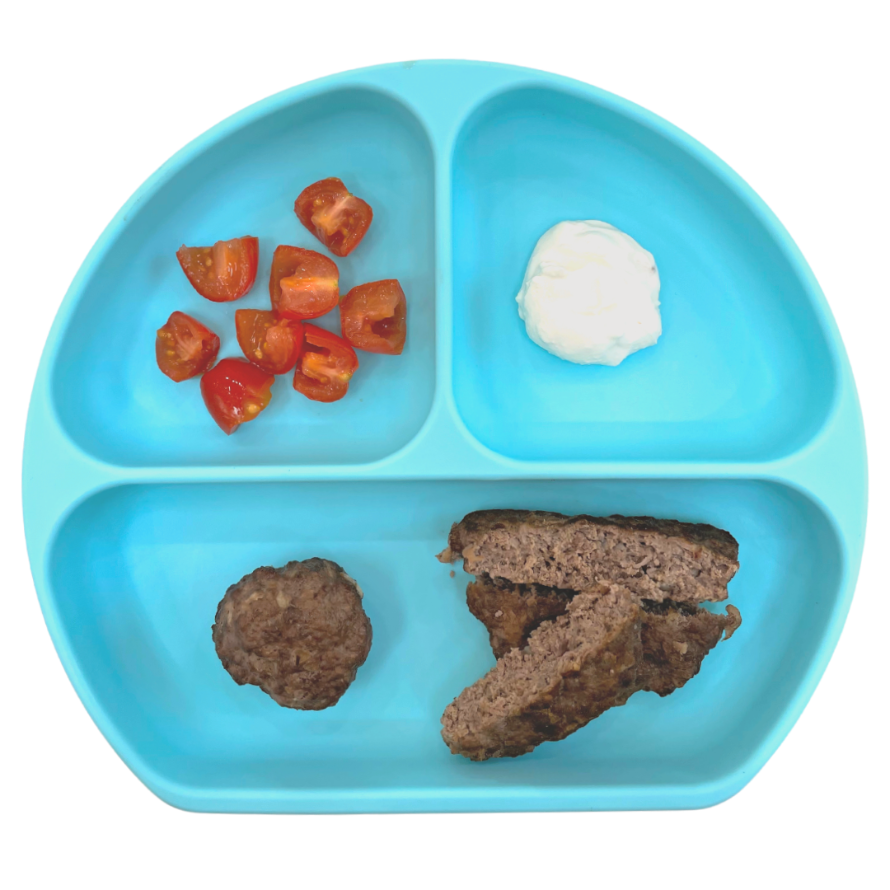
Any type of unprocessed meat is safe for your baby! It doesn’t matter if it’s organic, grass fed, or conventional meat (although grass fed and organic will have a better fat profile, but it’s not a big deal if you can’t afford it).
One of the only things to aim for is meat that’s not pre-seasoned or marinated, as it’s almost guaranteed to contain a high amount of salt. I’d rather see you add seasonings and marinades at home where you can control the amount you put in.
Avoid all processed meats, such as bacon, ham, hot dogs, and sausages (unless homemade), as they’re very high in sodium and nitrites/nitrates, which increases the risk of cancer, and honestly, is not needed in a baby’s diet. Understandably, it can sneak its way in, especially after one year of age, and hey – nothing will happen to them from a few indulgences. But generally speaking, try and avoid them when you can.
Can baby eat meat with no teeth?
There are a couple of myths to bust about meat. First off, it’s not a choking hazard just because it isn’t puréed. Babies don’t need teeth to chew meat (or other solid foods!).
The goal is to cook and serve meat so that it passes what we call “the squish test”. This is when you place a piece of meat (or any other food for baby) between your thumb and forefinger and push down. If you’re able to squish the food, or break it into pieces with just the pressure of your two fingers, your baby will be able to do the same with their gums. Actually, their gums are much stronger so this test is playing it safe!
How to keep meat safe for babies
Babies can chew meat most easily when it’s both tender and moist. Here are our top tips on what to do when cooking and serving meat to make sure it can be safely served to your baby.
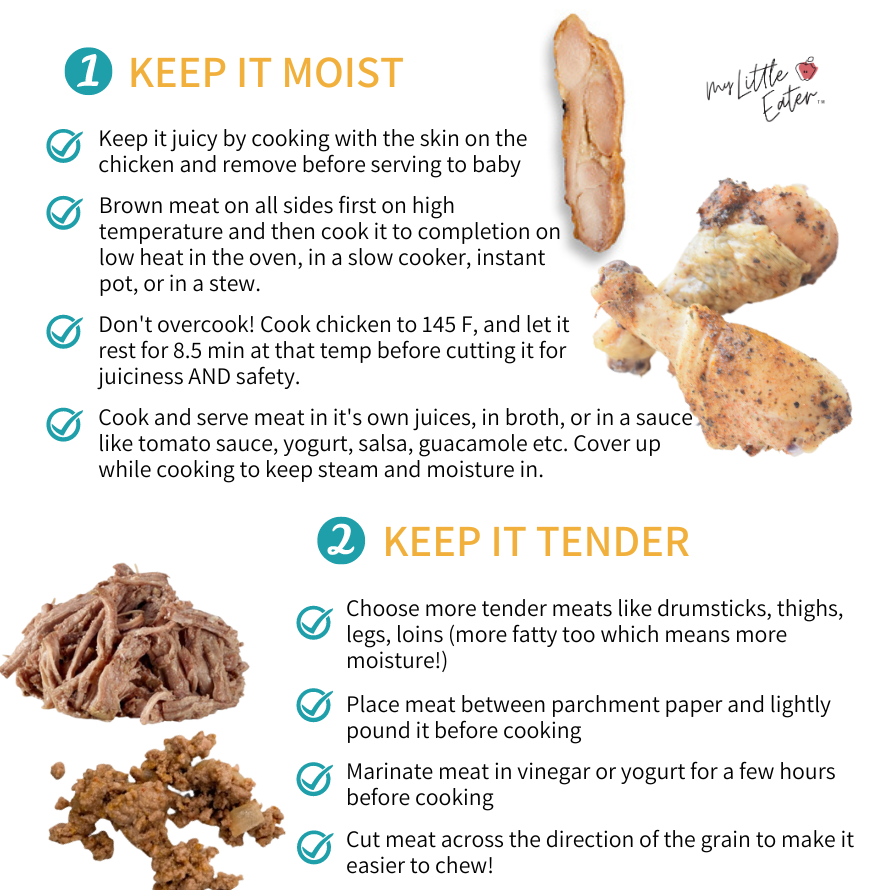
#1: Keep it moist!
Try and maintain as much juice and fat on the meat as possible during cooking. It will not only keep it moist, but the fat is also beneficial for your growing baby. We recommend keeping skin on drumsticks, breasts, or chicken thighs when cooking them so that the fat from the skin keeps the meat moist. We would then remove the skin before serving it to your baby.
When possible, brown any meat on all sides first at a high temperature in a cast iron pan, or grill, and then cook it to completion on low heat. Whether that be in the oven, in a slow cooker, or braised/stewed over the stove. This will break down the collagen in the meat and tenderize it.
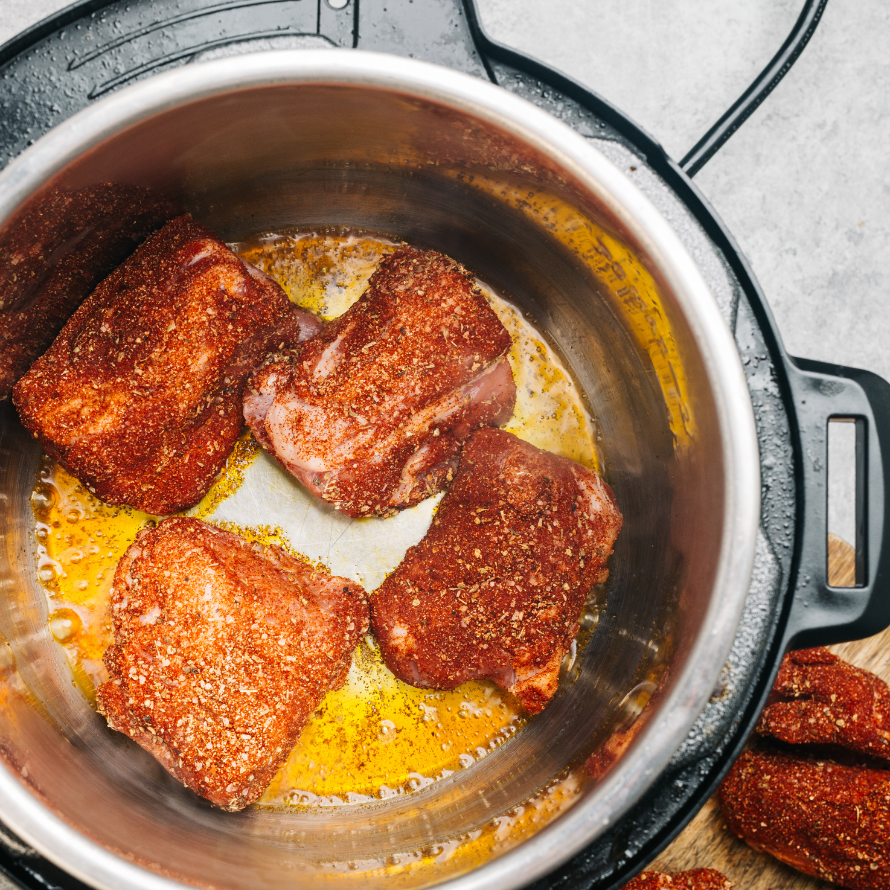
You definitely need to make sure to serve fully cooked meat, especially for babies, but keep in mind this doesn’t mean cooking it so much that it becomes dry and hard. Aim to cook chicken and pork to 145°F (use a meat thermometer to check!) and have a holding time of 8.5 minutes before cutting into it, which will ensure any bacteria is killed off.
Higher than that, such as 165°F, will be okay for pieces of meat with more fat content that can withstand those temperatures, such as chicken thighs or drumsticks. However, it will likely produce tougher, drier meat for those pieces with less fat content, such as chicken breasts. Steak can be cooked a little bit under this (it’s okay to have a touch of pink inside if the steak hasn’t been poked with a fork and the outside is well-cooked).
Other ways to make meat more moist and easy to chew for your baby/toddler is to add sauces like tomato sauce, plain yogurt (we use that as a sour cream replacement all the time), salsa, pesto, and guacamole.
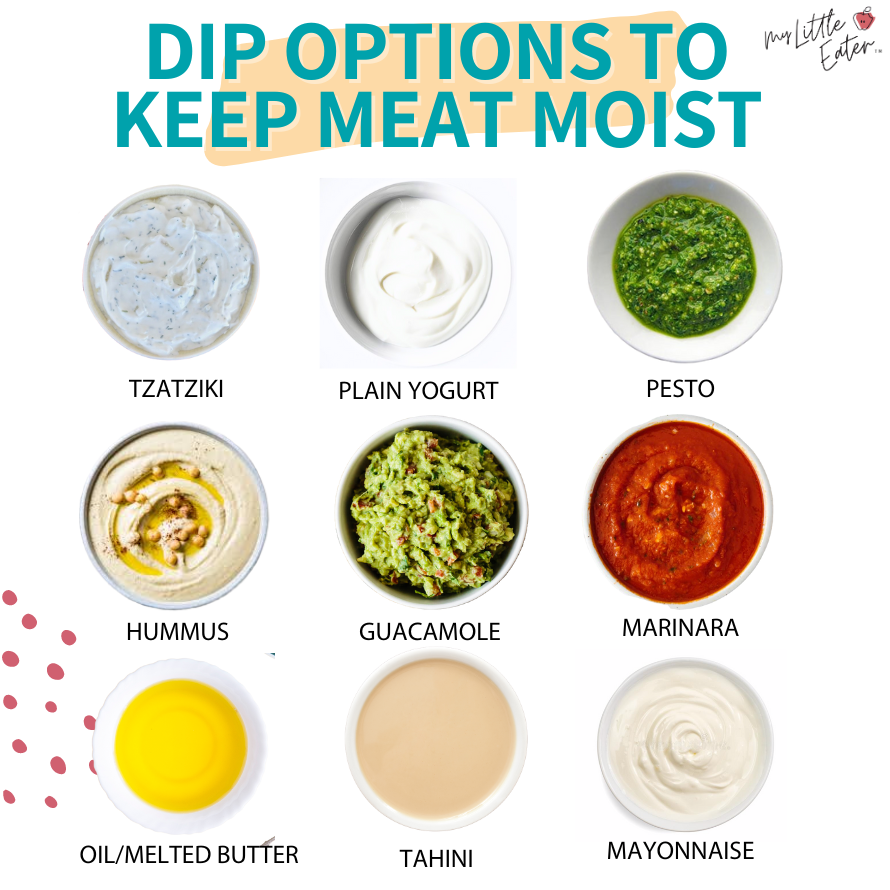
You can use these as something to dip into, or mix the meat right into it. Topping the meat with the broth or juices it was cooked in is another option (for adults and kids!)…it’s just so much more enjoyable to eat when it’s moist!
#2: Keep it tender!
As mentioned earlier, you want to make sure that the meat can be easily mashed between your thumb and forefinger – aka that it passes the squish test (see the video below).
A big part of keeping meat tender is not overcooking it, but you can also choose more tender pieces of meat, like a pork or beef loin. You can further tenderize any piece of meat, including chicken, by putting it between two sheets of plastic wrap, or parchment paper, and pounding it while it’s still raw.
Other tenderizing techniques include marinating it in things like vinegar or yogurt. Ultimately, choosing more tender pieces of meat and chicken, like drumsticks, thighs, and legs (which are all higher in iron too!) is going to be the easiest way to ensure the meat being served is tender enough for your baby.
Another tip is in how you cut the meat before serving it to your baby. Some may say this is taking it too far, but we find it helps when you cut perpendicular (or across) the direction of the grain (where the muscle tissues run). That way, you get lots of shorter pieces of meat fibres that fall apart more easily in their mouth, making it easier to chew.
Check out this 7 month old baby enjoying some pulled chicken!
How to serve meat to your baby
If you’re purée feeding, you can easily purée cooked meat with a little broth, water, or breast milk, either on it’s own or mixed in with vegetables like sweet potato, carrots, tomatoes, etc. Feel free to add any seasonings and switch up the flavors for lots of taste exposure!
For baby led weaning, you’ll want to form it/cut it in finger length sizes so it’s easy for your baby to hold, and generally speaking, at least 1-2” wide. Let’s go over some options for how to serve various types of cooked meat, plus give you some easy meal ideas!
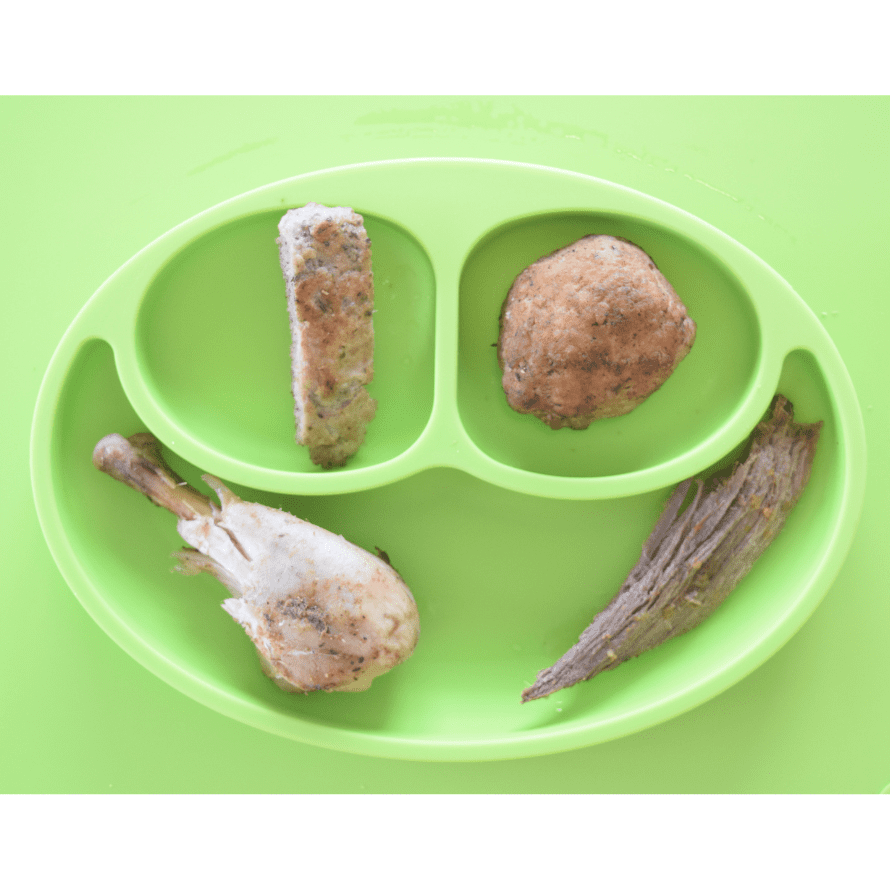
Ground meat in sauce
The easiest place to start with babies is by offering ground meat. It’s crumbly, soft, and moist, especially if you choose one with a higher fat content. You can just take any ground beef, turkey, or chicken, and offer it either in its own juices (use some of that fatty juice to keep it moist) or in a sauce like tomato or pasta sauce. Your baby can eat it with their fingers, or with a spoon.
Ground meat in a patty or finger-shape
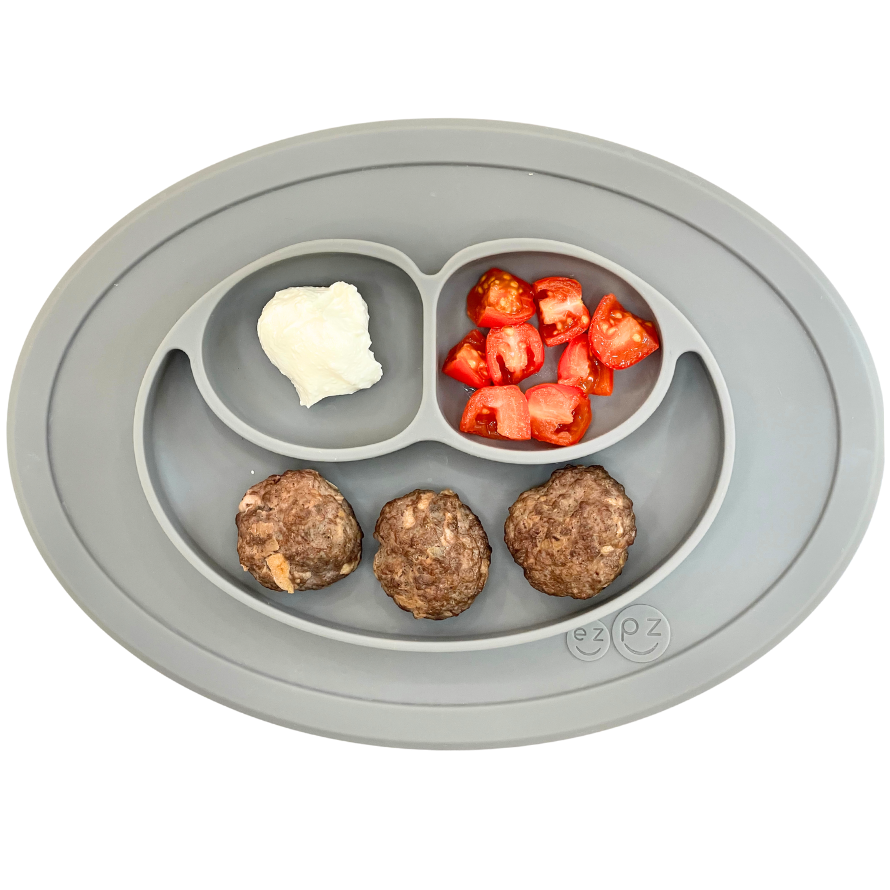
One of the easiest ways to serve ground meat is to actually form it into a patty and cut it into finger shapes, or even a large meatball. We also LOVE mini-meatloaves for babies and toddlers. Simply bake meatloaf in a muffin tin for easy to hold and moist meat.
A great trick to keep it extra moist is to add in some coconut milk or regular milk to your meatball recipe!! It makes it mushy even after it’s cooked (think IKEA Swedish meatball texture). If you’re adding any sort of breadcrumb to the meatball, soak your breadcrumbs in milk first before using them (called a panade), or just add in small amounts of milk to your meat mixture on its own!
Check out our Apple Sage Baby Burgers for one of our favorite ground beef recipes for baby led weaning, and a meal for the whole family!
Pulled meat in a slow cooker or pressure cooker
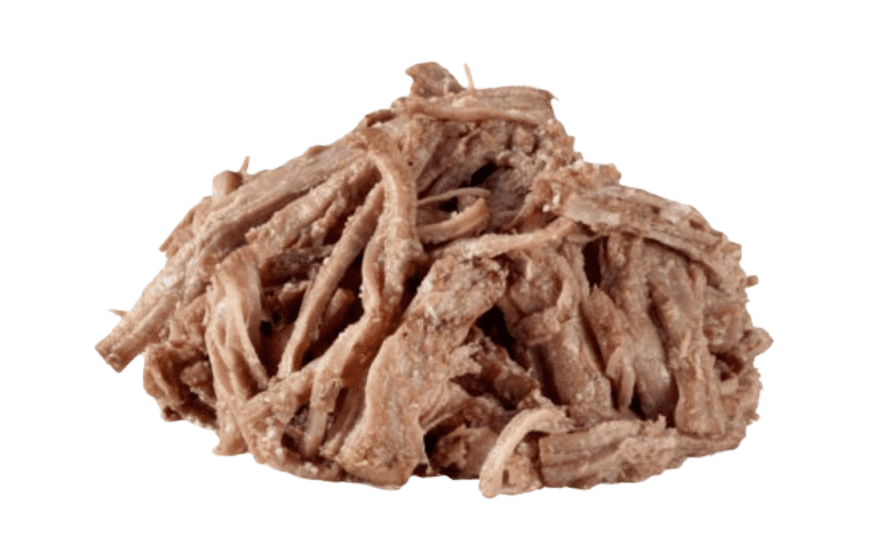
You’ll love how this turns out, and it’s perfect for babies because it just falls apart, is easy to chew, and stays really moist. You can pile up shredded slow cooked meat on the high chair tray to make it easy for your baby to grab onto with their fingers. Of course, you can also mix it into a sauce, or a purée like mashed avocado, salsa, or yogurt.
Check out our recipe for boneless leg of lamb in the slow cooker for a delicious meal the whole family can enjoy!
Braised meat
If you want super flavorful, tender meat, this is a great way to go – especially if you have more time on your hands to dedicate to this.
Learn more about how to braise meats if this is something new for you to try!
Meat in a stew or soup
You can make any soup or stew and just strain the meat, veggies, grains etc. from the broth and serve the soft pieces of meat to your baby! It’ll be soft from the long cooking time, and moist from the broth it’s been sitting in.
Meat on a bone
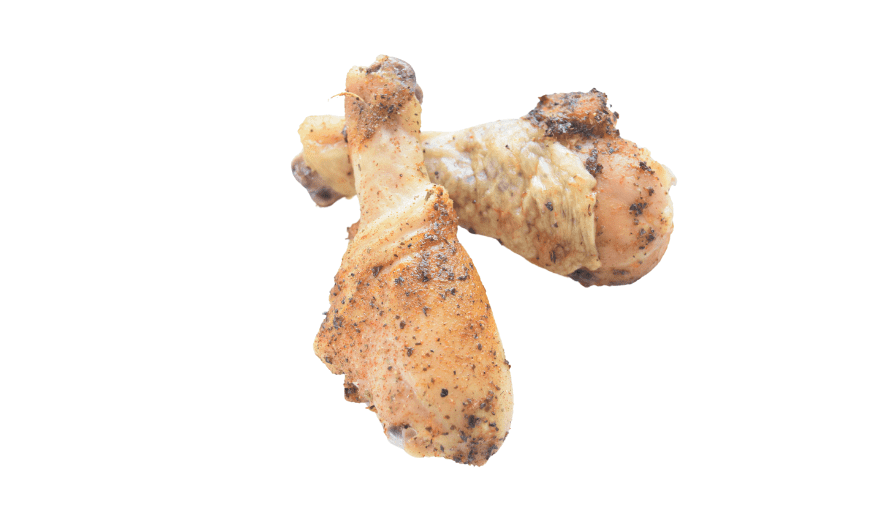
People always freak out when they hear this one, but it’s a great option because meat on a bone (like a drumstick or lamb chop) has an integrated handle that your baby or toddler can hold onto and take bites out of! Keep in mind…it’s large bones we’re talking about that they can’t take bites off of or break into pieces. Not small ones that can break, which would make them a choking hazard.
We bake chicken drumsticks often with a few types of roasted veggies all on one pan. This is something that your baby can enjoy eating the exact same way you do! As long as you know how to safely serve it (which I show you how to do in my Baby Led Feeding online course) you’ll find this to be a low hassle way of offering meat!
Grilled meat
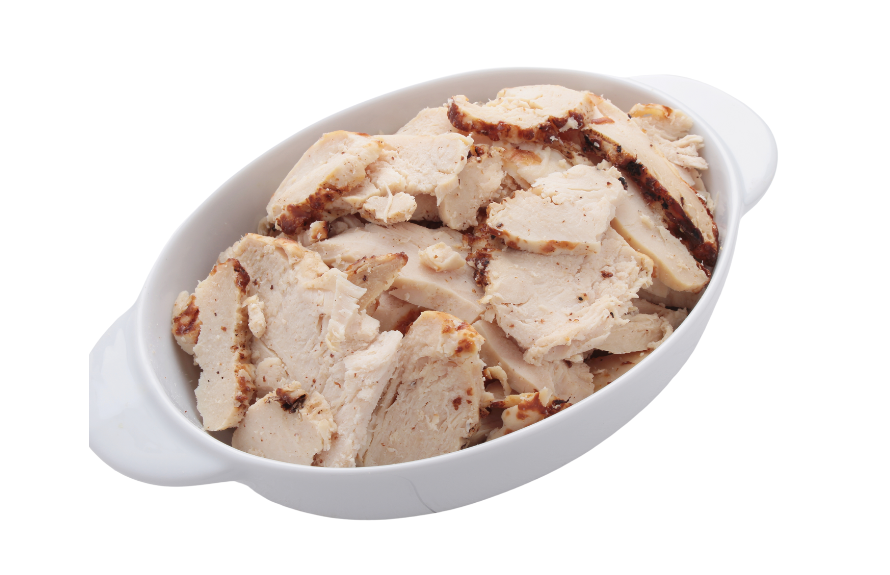
Grilling meat is trickier to keep moist and tender, but can definitely be done. Grill chicken breast in a covered state, like covered with a silicone mat, a lid, or with an aluminum foil tent over it. This will keep all the steam and moisture on the meat versus evaporating into the air, and will ensure you don’t overcook it.
Again, feel free to offer a dip to keep the meat moist and easier to chew for your baby. You can also spread some on top before serving if your baby isn’t ready to try dipping just yet.
Learn more about barbecuing food for your baby and how to do so safely.
Pan-fried meat
Pan-frying meat (like steak!) can work as a great food for your baby to gnaw and chew on, in larger pieces, when they don’t have teeth. If you ever have a tougher meat for dinner, like steak, this is great for them to just suck and gnaw on.
Believe it or not, by sucking the juices out of it, and gnawing on it, they can actually extract a decent amount of iron from it, so it’s a great nutritious option even if they don’t ingest much (or any).
If they have teeth and can chew better (around 12 months +), you can cut more tender pieces of steak into small 1-2” pieces for easier chewing and to reduce the risk of choking.
Baked
Baking is easy and can work if you douse the meat in lots of fat (again, we suggest keeping the skin on the chicken to keep the fat sizzling on it while cooking). You can also cover it with foil to keep the juices in, and the steam on the meat, so it stays nice and juicy!
Pâté
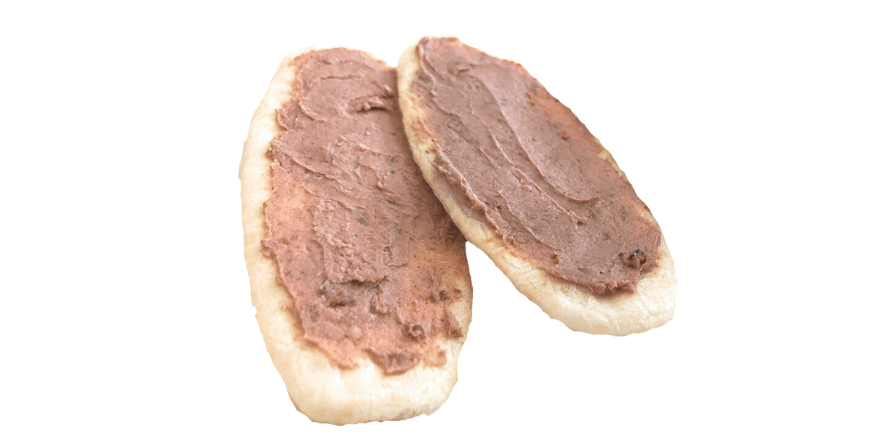
We love pâté for babies and toddlers! It’s a nutritional powerhouse with every pâté containing at least some liver, and so it delivers a jam packed amount of iron, b12, zinc, and so on. It’s easy to spread on pieces of toast or crackers, and doesn’t require any chewing!
However, because liver is SO nutrient dense, there is a possibility of overdosing on Vitamin A if it’s eaten more than once a week. Try not to offer it more than that, but otherwise…it’s a beautiful way to serve meat!
Hopefully this gives you TONS of ideas on how to serve meat to your babies and toddlers and really helps you see that this is not a food group you need to avoid or be scared of!
If you’re feeling overwhelmed about starting solids and you’re not sure where to begin, join our FREE workshop – How to start solids: A realistic first week of feeding your baby. This workshop is for parents ready to feel confident and prepared to start solids—without all the guesswork.
Learn exactly what to feed, when to feed it, and how to do it—step-by-step—with expert guidance from pediatric dietitian, Edwena Kennedy. Plus, get a FREE 5 day meal plan just for attending!
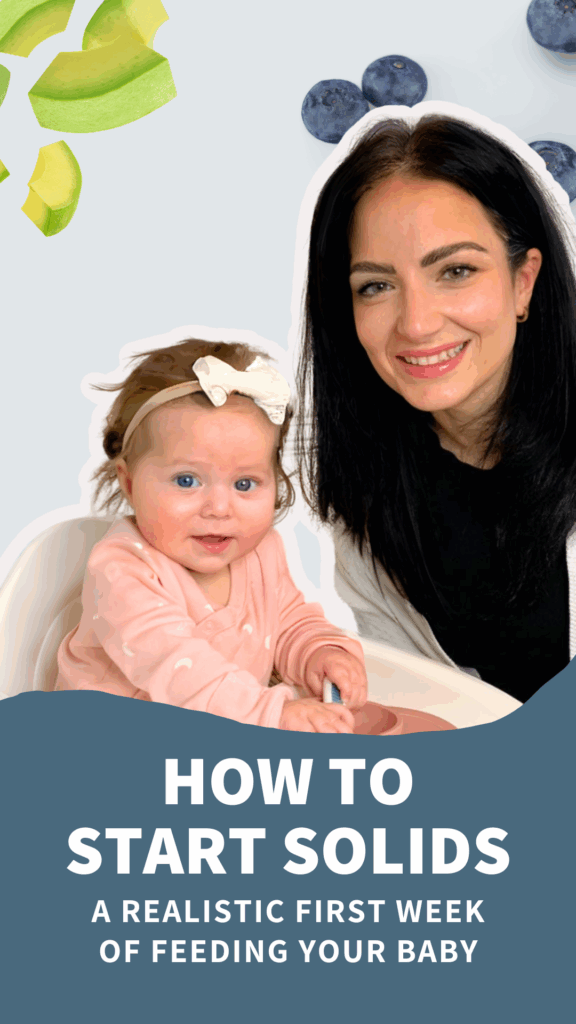

FAQ's about meat for babies
Is meat a choking hazard for babies?
No, not necessarily, provided you’re following the recommendations outlined above to serve it safely. Remember to keep the meat moist, tender, and serve it in baby-safe formats, like as a meatball, shredded into strips, or cut into finger length pieces.
There are certain cuts of meat and certain preparations that will be a choking hazard for your baby, such as cubed pieces of steak, for example. So again, follow proper preparation methods and consult our Texture Timeline™ Video Library for how to serve all foods safely depending on the phase of the timeline you’re in, if you’re ever unsure. This can be found inside our Baby Led Feeding online course and once you’re in you have lifetime access to search any food you need!
Do babies have to eat meat?
Meat is one of the first foods we recommend when starting solids because it provides an excellent source of heme iron. This is the type of iron that is more easily absorbed by the body, compared to non-heme iron that comes from plant sources like beans or tofu.
And because babies need more iron than an adult male beginning at around 6 months of age when their iron stores start to deplete, it’s incredibly important that we’re serving iron at each meal when starting solids.
That said, we do support those that would prefer to follow a vegetarian or vegan diet, or those who avoid meat for other reasons. It will be more difficult for your baby to get all of the nutrients they need, like iron, which means you’ll have to be more intentional with their menu. Feel free to reach out for a custom plan as we do offer one-on-one counselling as well!
Can babies eat deli meats?
As discussed above, we don’t recommend serving processed meats to babies or toddlers due to the higher levels of sodium and the fact that they contain nitrates/nitrites which are linked to negative health outcomes. Processed meats include things like pepperoni, salami, bologna, hot dogs, store-bought sausages, etc.
Of course, occasionally these will be offered for birthdays, summer BBQs, etc. and that’s ok! But in general, we don’t want to be offering these regularly, and if you can avoid them completely for babies under 12 months of age, that’s what we would recommend.
Can you reheat meat for babies?
Yes, you can! When storing meat after cooking, we recommend storing it in the fridge with broth. When reheating the meat be sure to spoon some of the broth in with the meat before warming it up. The broth helps rehydrate the meat so it stays moist and tender for your baby.
You can safely store meat in the fridge for a maximum of 3 days in an air-tight container. After this point, we wouldn’t recommend serving the meat to your baby.
What is the best way to cook meat for a baby?
Our favorite way is to slow-cook the meat. Not only is this an easy, hands-off method for busy parents like you, it produces really tender, moist pieces of meat for your baby.
You can use this with chicken, beef, pork, turkey, or lamb – and we’ve got the perfect lamb recipe for you to try below! If you want more ideas for serving meat to your baby, including completely balanced meals, grocery lists for each week, and tips on safely serving the meal to your baby, check out our 60 Day Baby Led Feeding Meal Plan. We’ve even got a simpler version of this lamb recipe in the plan (and this one is already SO easy!), with tips for how to serve it and what to serve it with!
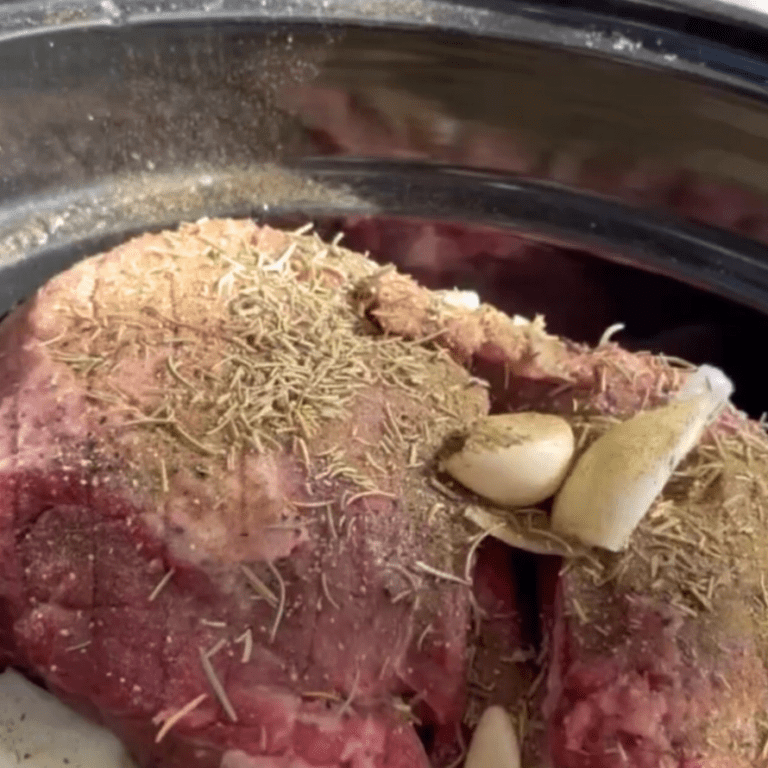
Slow-Cooker Boneless Leg of Lamb
Equipment
- 1 crockpot
Ingredients
- 1 boneless leg of lamb
- Salt & pepper (to taste)
- 6 cloves garlic
- 2 onions (roughly chopped)
- 2 tsp dry oregano
- 2 tsp dry rosemary
- 2 tsp dry thyme
- 2-4 cups low-sodium beef broth (enough to cover everything)
Instructions
- Place the leg of lamb in the slow cooker. Do not trim the fat before cooking, keeping the fat on helps ensure the meat turns out moist enough for baby to eat safely. You can always remove any excess once it's done cooking.
- Add the spices and herbs, garlic, and onion to the crock pot. Pour the beef broth on top, ensuring that everything is covered with broth.
- Cover and cook on low for 7-8 hours or on high for 5-6 hours.
- Once cooked, remove from the slow cooker and shred before serving to baby. Offer the meat in finger-length strips with a bit of the broth from the slow cooker on top to keep it moist and juicy!
Video
Notes
Is this helpful? Pin it to save for later!
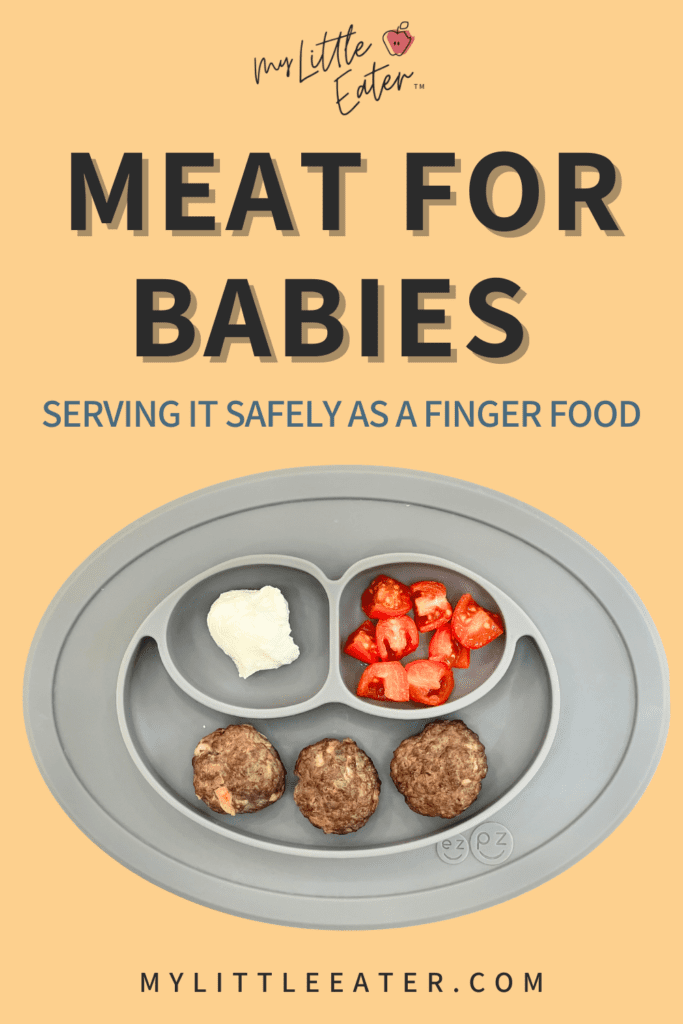

Edwena Kennedy, RD
Founder and lead Registered Pediatric Dietitian at My Little Eater Inc., creator of The Texture Timeline™, and mom of two picky-turned-adventurous eaters.

Edwena Kennedy, RD
Founder and lead Registered Pediatric Dietitian at My Little Eater Inc., creator of The Texture Timeline™, and mom of two picky-turned-adventurous eaters.
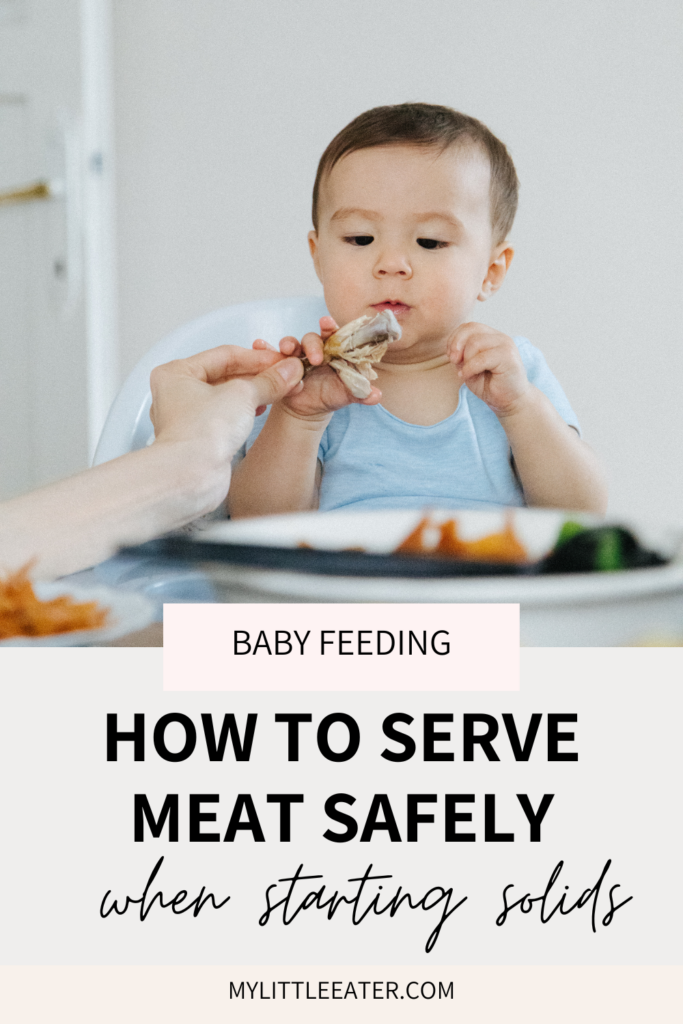
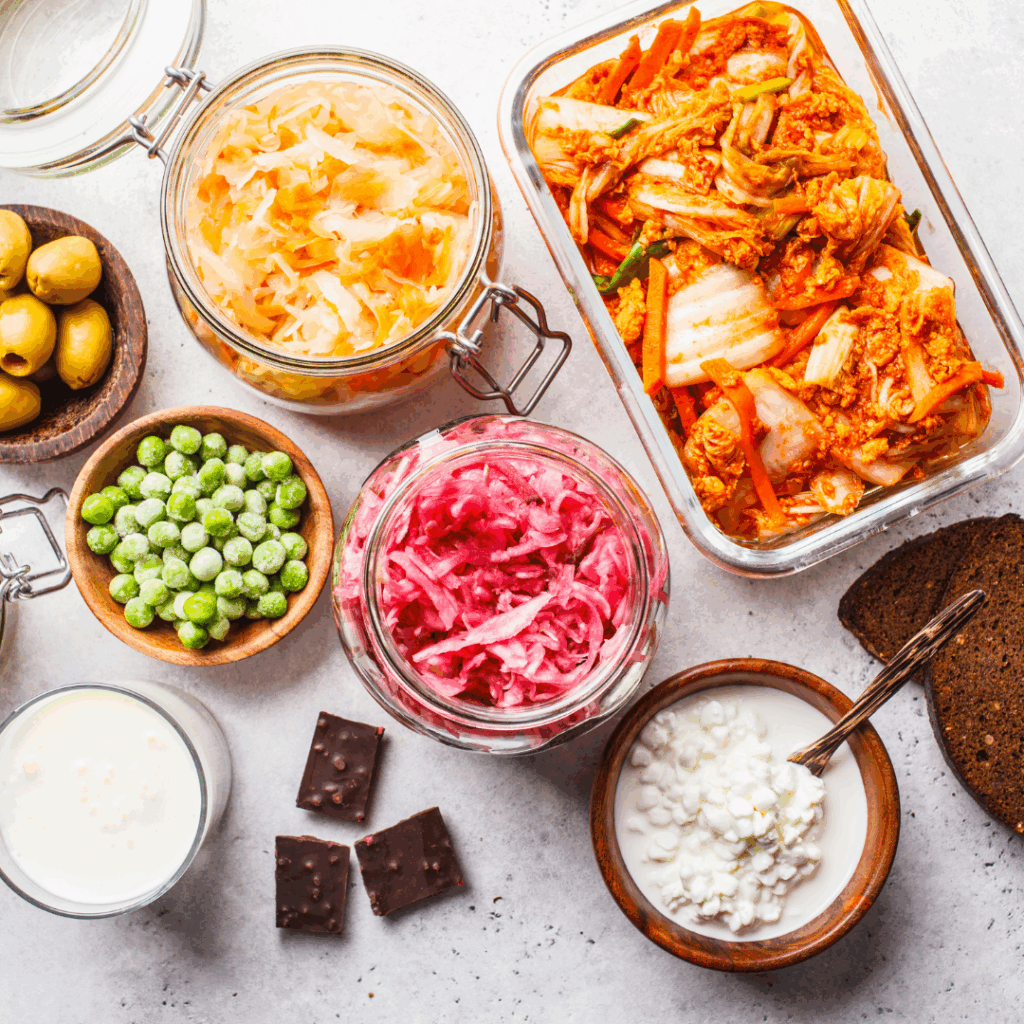

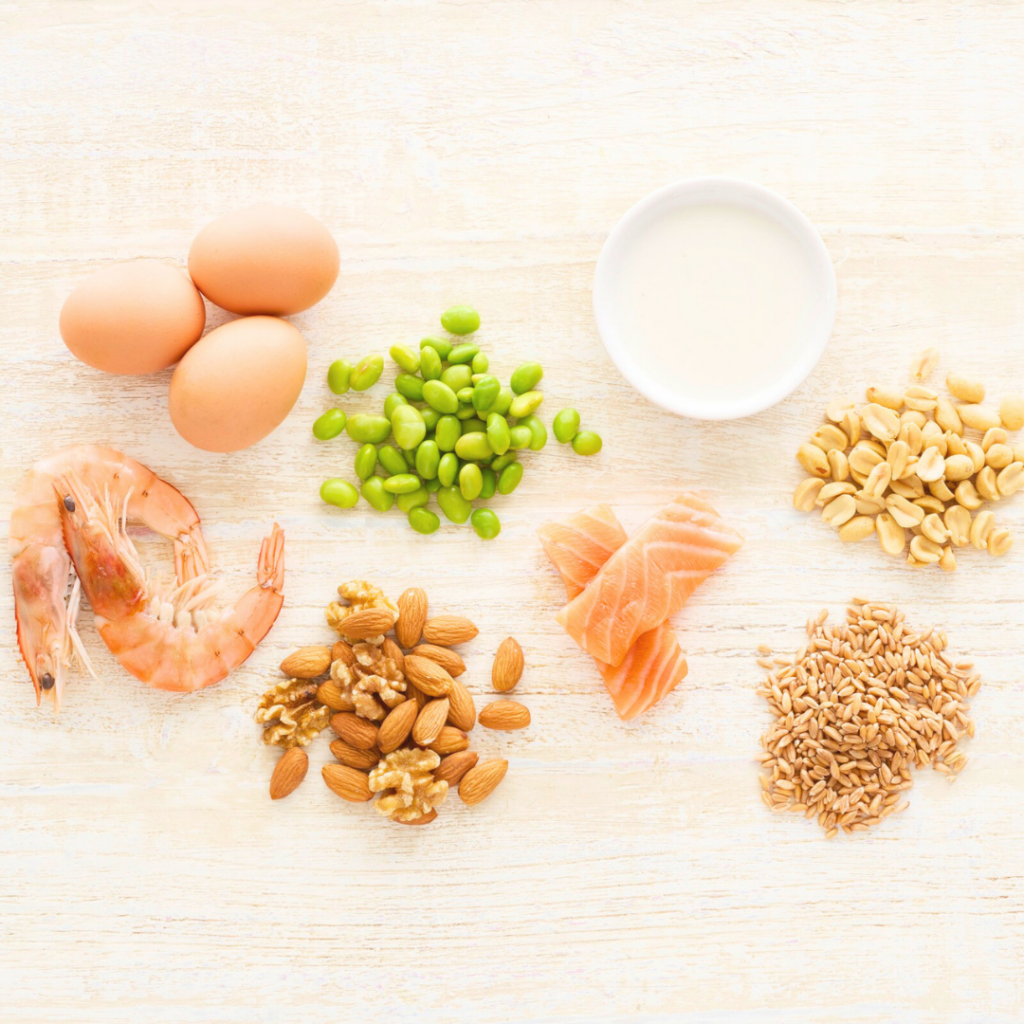






3 Comments
Going from a purée to a chunk of meat seems like too much of a leap. (As an older grandmother taking care of LO, baby led weaning is not something I’m comfortable with). She just turned 10 months, we are starting on chunkier fruits and veggies, but I struggle with how to prepare meat. She’s not used to really chewing yet, but I’d like to make it chunkier than a purée. Any suggestions? ( we already watched the video)
Thank you.
We completely understand being nervous about making that jump from one texture to another, so you can certainly start more gradually. What about doing ground meat and then mixing it into something like whole fat yogurt. The yogurt helps keep the meat moist making it easier for baby to manage, and it will give the texture of a lumpier puree without having to play around with pureeing the meat to the right consistency. If you search “ground beef” on our blog page we have another blog with info on this option 🙂
Foods like mashed bananas and boiled potatoes are excellent for including in a baby’s diet. These are staples in Indian kitchens and are perfect for helping babies gain weight.